Child Car Seat Expiration Date Passed Manufacturing Date
Deaths from car crashes among children age 12 and under decreased by 43% in the past decade and a large part of this decrease comes from proper usage of car seats.
This article will tell you:
- When car seats expire by manufacturer
- How to find the expiration dates
- Why car seats expire
- How expiration dates should factor into your buying decision
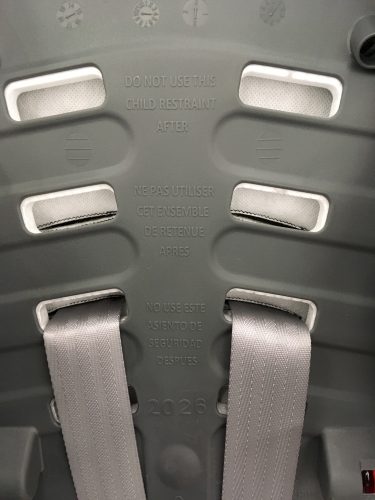
Expiration Dates By Car Seat Company
While we do our best to keep this information up-to-date, please check with the car seat manufacturer for the most current information.
Most car seats last for 6 to 10 years depending on the company and the material used. A few, like Bubblebum (4 years) are shorter, and others like some Peg Perego's are longer. Car seats reinforced with metal last longer. Different types of car seats have different expiration dates. Typically, infant car seats with a base only last about 6 years. Convertible seats can last longer for a life of up to 10 years. Booster seats also last about 10 years.
Take a look at each brand and how long their car seats can protect your infant or child. Keep in mind, plastic has a life expectancy of about ten years and no seats on the market now last longer than one decade.
Most of the best car seat brands stamp or emboss the expiration date directly on the shell of the seat.
Baby Trend Car Seat Expiration Dates
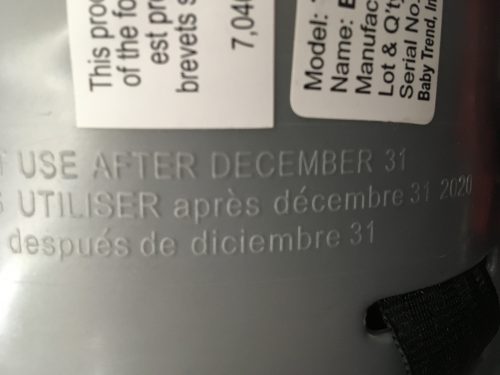
Expiration date stamp
You will find the manufactured date along with the serial number on the underside of the car seat and the bottom of the base of your Baby Trend car seat. Each seat will have a "Don't Use After…" date molded into the seat, which the company calls a hot stamp. I had to call Baby Trend for more accurate information on expiration dates as their website along with most websites offer extremely limited information.
Here is a quote from the EZ Flex Loc Infant Car Seat manual: "Discontinue use of the Safety Seat and Base after six (6) years from the date of manufacture. The date of manufacture can be found on the label located on the underside of the Safety Seat or Base."
Infant Car Seats – expire after 6 years
Convertible Car Seats – expire after 7 years
Booster Seats – the top portion and harness expire after 6 years and the bottom portion expires after 10 years.
Britax Car Seat Expiration Dates
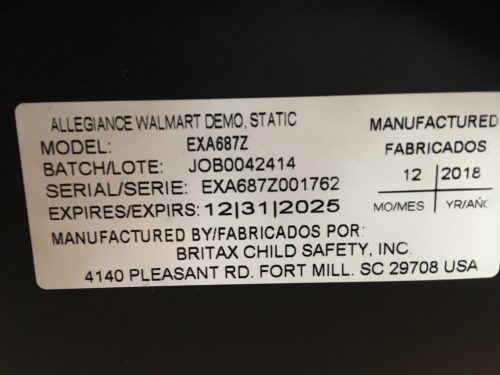
Britax broke up their car seats into two different sections starting almost a decade ago! Some of the dates are listed as before and up to June 2010 and then after June 2010 which is relevant now. Hopefully, no one has a car seat from before that, still in use.
Infant Car Seats – Expire after 6 years.
Convertible –Up to June 2010, car seats expired after 6 years. After June 2010, car seats expire after 7 years.
Convertible ClickTight – Expire after 10 years.
Belt-Positioning Booster Seats – Up to June 2010, has a life of 6 years. After June 2010, the car seats had 6 years.
Harness-2 Booster Seats – Up to June 2010, the seats had 9 year life spans. After June 2010, the booster seats had a life of 9 years.
Chicco Car Seat Expiration Dates
I found a few expiration dates after some hunting on Chicco's website but not enough information. A quick phone call answered all my questions. Chicco wants customers to know to dispose of car seats after the "Do No Use After" date printed on the bottom of the car seat and the base.
Infant Car Seats – expire 6 years after the manufacture date
Convertible and Booster Seats – expire 8 years after the manufacture date
Clek Car Seat Expiration Dates
All of Clek's car seats include a life span of 9 years from the date of manufacture. The sticker can be located on the back of the car seat.
Combi Car Seat Expiration Dates
All Combi car seats expire 7 years from the date of manufacture. This information is stated in the instruction manuals and on the white label located on the bottom of the car seat.
Cosco Car Seat Expiration Dates
Cosco car seats have the expiration date embossed on the seat and listed in the manual.
Infant Seats – Before December 14, 2013, expire after 6 years. After December 14, 2013, expire after 10 years.
Convertible Seats – The APT and the Scenera Next DLX – Before December 14, 2013, expire after 6 years. After December 14, 2013, expire after 10 years. The Scenera Next – Before December 14, 2013, expire after 6 years. After December 14, 2013, expire after 8 years. The Easy Elite – Before December 14, 2013, expire after 8 years. After December 14, 2013, expire after 10 years.
Booster Seats – Before December 14, 2013, expire after 6 years. After December 14, 2013, expire after 8 years.
Diono Car Seat Expiration Dates
Each of Diono's car seats comes with specific expiration dates. All of their dates are found on the bottom or back of the car seats.
Diono Radian models expire 10 years from the date of purchase. With the harness, the seat lasts for 8 years and as a booster for 10.
The Diono Rainier, Pacifica, and Olympia models expire 10 years from the date of purchase. With the harness, the seat can be used for 8 years and as a booster for 10.
The Monterey booster seat lasts for 8 years.
The Monterey XT, Cambria, Hip, and Solana last for 6 years.
Evenflo Car Seat Expiration Dates
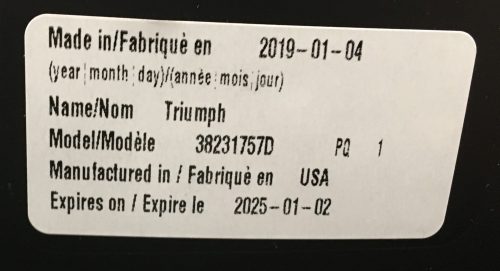
All of Evenflo's car seats expire 6 years after the date of manufacture except for a few exceptions. All of their car seats offer this important information on their seat labels.
The Symphony expires 8 years after manufacture because of it's extended use from infant to belt-positioning booster.
The Transistions and Evolve 3-in-1 Combination car seats expire 8 years after manufacture date because of extended use from harnessed care seat through no-back booster (NOTE: many states require children to use car seats up to 10 years or a certain height. If this applies to your state make sure to find an extended use car seat that lasts for the life of your child's car seat years).
Graco Car Seat Expiration Dates

Most Graco car seats have the either the useful life or the expiration date stamped on the seat.
The Date of Manufacture is easy to find and the expiration date is: Manufacture Date + Useful Life. Graco's website has some good information. offers the most information about expiration dates.
Graco states the "useful life" of a car seat is ten years for the belt-positioning booster and for steel-reinforced belt path car seats. For plastic-reinforced car seats, the date drops to 7 years. Locate these dates in the product manual and registration card. The company does, however, recommend customers only use their car seats for six years due to wear and tear.
Maxi-Cosi Car Seat Expiration Dates
Maxi-Cosi molds expiration dates into the shell and some times even in the base of their car seats. They do not state the exact date per car seat but instead state the car seats are good to use for 6 to 8 years from the date of manufacture.
Peg Perego Car Seat Expiration Dates
Peg Perego's car seat dates are printed on the stickers under their car seats.
Infant Seats – Expire 7 years from manufacture date.
Convertible Seats – Before 2015 car seats lasted 7 years. After November 2015 car seats expire after 10 years.
Booster Seats – Before October 2015, car seats expire after 7 years. After November 2015 car seats expire after 12 years.
Urbini Car Seat Expiration Dates

Urbini's car seats expire between 6 to 8 years from the manufacture date. Look for the date on the bottom of the car seat and the base.
Uppababy Car Seat Expiration Dates
All Uppababy car seats expire 7 years after the date of manufacture. You can find this information on the labels on the bottom of the carrier and the base.
Safety 1st Car Seat Expiration Dates
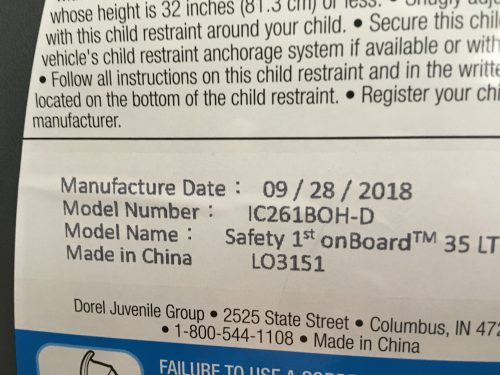
Safety 1st car seats have the expiration date embossed on the seat and listed in the manual.
Every single car seat made by Safety 1st has a website page explaining their car seat expiration dates. Please check out your car seat model on their expiration page. All of their car seats have a life span of 6-10 years with the newer car seats – including infant, convertible, and booster – lasting longer than previous models. Find the date of your car seat form Safety 1st under the seat on the label.
Why Car Seats Expire
Now that you are aware car seats do expire, you may want to know why they expire. Take a look at the five reasons car seats expire. The reasons may surprise you.
New Standards and Innovation
Every year car seat companies find new and innovative ways to improve car seats and make them safer for your baby. Car seats change drastically over the years. For example, the LATCH system was not around before 2002 and now every car seat has this tether system.
Think about Apple iPhones. Every year Apple finds new and innovative ways to update the phone and make it more functional for customers. Car seats are the same way. Every year new models enter the scene.
If you want the newest and the best car seat for your baby, buy a brand spanking new car seat with all the newest innovations. My personal favorite innovations in car seats include all of the convertible car seats. My children had three car seats apiece. The only transition for me was taking off the back of the booster seat.
Now, new innovations include leg stability, ergonomic car seats, and rear-facing longer. Check out below for a history of car seats and see how much car seats have changed over the decades.
Many car seat companies do their own crash testing and with new test and innovation, car seats evolve to better survive crash tests and keep your baby protected. Now companies use computers to simulate new seat models and figure out the issues before making new seats to cradle babies.
Wear and Tear
Car seats have life spans just like everything else. The sun can warp the plastic along with extreme heat. Even extreme cold can make plastic brittle. Putting the seat into the base for a year can cause little cracks. Seat belts get grimy or too elastic. Basically, car seats break down over years of use.
Do you have a child? If so, you know how nasty car seats get. Not can get, GET. My third child was the absolute worst. I needed a hazmat suit to clean under her car seat when I take it out to vacuum. Crayons, goldfish, cheerios, caked on dried milk, the list goes on.
Now she is eight and in a booster seat. I learned, and she is no longer allowed to eat in the car, but still, she manages so many crumbs it's embarrassing! This nasty mess is one reason car seats expire. Not to mention the hot sun!
Car seats are made of heavy duty plastic, with some cloth and sometimes some metal, but overall it's plastic. The car seat stays in the car all day every day in the hot sun. Ever put a plastic container in the microwave? Like plastic containers, car seats change structurally in the heat too. These are the devices meant to save your baby's life in the event of a car crash!
Recalls
While a minor issue, recalls are real. Not all car seats get recalled. A very small percentage of car seats end up on the recall list. As a matter of fact, the number is under twenty for the last three years. But, the fact is, recalls happen and you do not want your baby in a seat that's been recalled.
Why is this a reason for a car seat to expire? Because yours may have been recalled and you weren't notified. Some moms remember to check every so often if their baby products were recalled. Others, like me, didn't think to after checking the first time.
Lastly, many parents do not know how to check if a car seat was recalled. Here is a link to check if for recalled car seats. Go check now! What are you waiting for?
Registering your car seat provides the company with your information so they can send you updates. This is great if the company has a recall or you need to buy extra parts and safety information. Some companies may even email you when the car seat you purchase expires. I would recommend finding the date and putting it into your computer calendar so you don't have to think about the expiration date.
Safety and Lifespan
Car seats are only meant to last for about a decade or a few years less. The safety features in car seats are only guaranteed for the lifespan of the seat. Most companies only test the safety of a car seat for the life listed on the seat. They cannot and will not test the safety performance of an older car seat.
Most car seats are made of plastic because it's lighter and easier for parents to carry. Also, plastic is more comfortable for babies along with fabric and padding. Just like adults, babies do not want to sit in metal. Another consideration is that metal is an issue in an accident.
Plastic may not last as long but is less likely to damage a baby in an accident. If an infant car seat was made completely of metal, you would never want to carry the car seat around either! Plastic may have a shorter life span than metal but is the best option for car seats.
The naked eye may not notice damage. Even a tiny fracture can cause structural damage. During a car accident is not the time you want to find out the car seat didn't do its job because it was being used past the expiration date.
Replacement Parts
Another reason car seats expire is because of replacement parts. Designs change and older seats fall to the wayside. Companies do not have space or the inclination to keep replacement parts for every single model car seat they have ever made.
Once a car seat is no longer produced, the company stops making replacement parts. If you cannot replace important parts of a car seat, you cannot put a baby in the seat.
A replacement part can mean the difference between using the seat you already invested in or needing to buy a new seat long before the expiration date. Car seats aren't cheap and if you only need a new strap or tether, calling the company and replacing the part may save you time and money.
Older car seats may end up needing all of the parts replaced from frayed fabric to loose seat belts. At this point of needing multiple replacements, its time to just replace the car seat!
Other Important Information
Just knowing why car seats expire is not enough information for experienced mommies. The expiration date impacts quite areas of car seats and you need all of the facts. Take a look at the other important considerations expiration dates have on purchasing and using a car seat.
Car Seat Expiration Date Laws
SafeRide4Kids offers a good summary of car seat laws by state. Every state has child car safety laws and most states require "proper use" child restraint devices. Proper use includes honoring expiration dates, so it is illegal to use car seats beyond their expiration dates in most states. It is of course, unwise to do so, regardless of the law.
Federal law regulates the safety standards for car seats but does not regulate the expiration dates of car seats. This does seem slightly suspicious. If laws do not state car seats need expiration dates than companies provide these dates for their own benefit, or so it may seem.
While shorter expiration dates benefit the companies, the dates also benefit babies. As I showed you above, car seats expire for several very important reason not just one. Sure, it may benefit the companies for seats to expire, but this does not mean you and your baby will not benefit. Car seats last the life of one baby.
Car seats do have to pass rigorous safety tests. Each state has car seat laws. Thankfully, laws have helped to ensure the safety of cars for children. The original car seat in 1921 was little more than string or a leash! Legislation helps to protect babies and children and we can expect at some point the government will regulate car seat expiration dates.
What to Do with an Expired Car Seat
Some companies offer a recycling program for expired car seats. Clek is one of the brands with a recycling option but you have to spend money to ship it back to the company ranging from $25 to $45.
Target also offers a recycling program. The program trade-in dates are from April 22nd to May 4th, 2019. Not only while Targets nationwide recycle your old car seat, but they will also give you a 20% off coupon towards a new car seat base, car seat, travel system, stroller, high chair, bouncer, playard, or swing. Use the coupons online or in stores but car seats but bring the old car seats into the store.
Of course, you could just leave the car seat to rot in your garage, basement, or attic. Or you could use the space for something else which may lead you to sell the car seat in a yard sale or give it to a charity. Before you do so make sure to put the history of the seat on a note for the next owner and check the expiration date and find all of the extra parts to go with the seat. Do not give away an expired or almost expired car seat. If the car has less than two years, get rid of it.
Throwing Away a Car Seat
If you decide to throw out an old or expired car seat, make sure to throw it away in a way where it is no longer usable. Cutting the seat belt is the easiest method of making the seat unusable. Check with your local recycling center to find out if your car seat is recyclable there or if it tossing it in the regular trash is an option.
Eighteen different states including, Arizona, California, and Texas offer recycling options. Most curbside pickups will not take a car seat, however, and you will need to drive the seat down to the trash center.
Car Accidents and Car Seats
If you are in a car accident, the safest course of action is to replace the car seat or booster seat. Even if your kid wasn't in the car but the car seat was. Car accidents involve crashes and crashes reduce the integrity of the car seat. Yes, car seats are expensive but your baby's safety is worth a new seat in the event of an accident.
Having said that, the NHTSA only recommend replacing seats in "moderate to severe" accidents. They provide some criteria for determining the whether the accident was moderate to severe. They say it doesn't have to be replaced if all of the following apply:
- Your vehicle was drive-able after the crash
- Airbags did not deploy
- There were no injuries in the accident
- There was no damage to the door nearest to the car seat
- There was no damage was done to the car seat itself (this may not be obvious)
Replacing a car seat that was in an accident during Target's trade-in event is a fabulous option to save a little dough. Otherwise, check with your insurance company to see if the car seat is covered. Most car insurance companies will cover the cost of a car seat. You can also keep an eye out for sales and maybe keep a second car seat available as a spare.
Car Seat Integrity
Remember, car seats are made of plastic, foam padding, and fabric. These materials may stand up to one accident – that's why they are safety tested with strict regulations – but they are not intended to maintain their shape or protect your baby through more than one accident. As I stated earlier, even if you do not see damage, it may just mean the damage isn't noticeable to the naked eye.
So imagine for a moment, you are in a small accident. A woman ran a stop sign and hits you. You slam on your brakes but the car still impacts the front of your car. Your baby is in the back seat. The car seat did its job and the baby is safe, he is just crying because the event was scary. Now let's imagine you end up in another car accident and you didn't buy a new car seat.
The seat now has structural damage and weak spots that don't necessarily show up on a visual inspection. The car seat buckles this time and doesn't stay where it belongs and your baby is injured.
Pick a Car Seat Based on Expiration Date
Car seat manufacturers want to get rid of old stock, which makes great sense for them from a business standpoint. For parents, however, buying an older car seat gives you less life. Imagine for example that you bought a car seat and when you take it out of the box and check the manufacture date it says it's already two years old.
Now instead of your car seat lasting six years, you only get four years. Forget using this car seat for a second kid! Make sure you check the manufacture date of a new car seat and if it was not manufactured the year you are in, then return the car seat and get one with the right year.
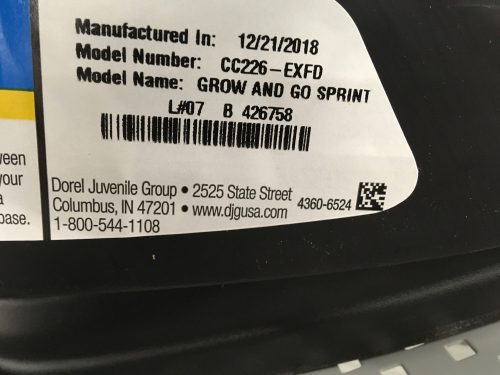
Alternatively, if you decide to buy a used car seat, you also need to check the expiration date along with worn or frayed areas among other issues (such as mold Ewwww) but if the manufacture date is older than two years old do not buy the car seat. Some items are better brand new and a car seat is one of them.
I am a cheapskate. My husband says thrifty, but I know the truth. I will save money anywhere I can on most everything. Somethings though, even I won't buy used. Bras, underwear, toothbrushes, hairbrushes, and car seats.
Do not expect a more expensive car seat to last longer than a cheaper car seat. All car seats need to meet the same standards so they are all safe. The majority of car seats are still made of plastic and plastic can only last for so long.
Buying or Using a Used Car Seat
Purchasing a used car seat would save a great deal of money especially with car seat prices going up every year. Not every family can afford brand new baby products. Some families use the same car seat and other baby gear for more than one or even two children.
If you do buy used, make sure you know the full history of the car seat. Maybe someone is selling a car seat at a yard sale and fails to tell you the seat went through a minor fender bender. Even a small accident can compromise a car seat. It's made of plastic! It's not made of gold or metal and therefore needs replacing more often especially when jeopardized.
Trying to save money isn't a bad idea. However, you may want to consider making a car seat the one item you buy brand new. If you still cannot afford a new one then make sure to keep these tips in mind.
Used Car Seat Checklist
- Check the car seat's expiration date. If the seat expires in two years or less, do not purchase.
- Look carefully at all the parts for damage or misuse. A good way to gauge misuse is the lack of stickers. If the stickers are gone or in terrible shape then find a different used car seat.
- Check to see if the fabric or seat belts are worn out or filthy. It's bad enough your baby will end up puking on the seat covers, she certainly doesn't need to sit in someone else's filth.
- Look online to make sure the car seat has not been recalled. Also, see if the company is still making the model you are hoping to purchase. If they are still making the model than you are more likely to find replacement parts for the seat.
- Remember plastic only maintains its integrity for ten years, even if the seat is missing stickers, you can tell by the fabric how old the car seat is, although, if it's missing stickers, do not purchase the car seat.
- Ask about the history of the seat. Buying used means you run the risk of buying a seat that was in an accident. This is a big issue as car seats are only capable of protecting a baby through one accident not multiple. Buy from someone you know to be doubly sure you can get the entire history.
- Do not buy a car seat without the manual.
- Make sure all the pieces are there. Check for the latch system, the seat belt and all the parts of the harness and that the seat belt still clicks into place.
- Check with a local car seat expert for assurance the car seat can protect your baby.
FAQs About Car Seat Expiration
Can you use expired car seats?
No. Do not use an expired car seat. Even if the seat looks good enough, there are a myriad of safety concerns when it comes to an expired car seat, among them outdated safety standards and degenerated plastic.
Are car seat expiration dates legitimate?
Car seats are manufactured to certain safety standards. The manufacturer cannot guarantee safety of the seat beyond a certain age, and the expiration date is established such that safety (of an undamaged seat) can be guaranteed until that date. While it is certainly possible that a car seat might be safe a day after expiration, there is no guarantee. As parent or caretaker it is your responsibility to guarantee a child's safety. Note that most states require "proper use" of a child's car seat, which requires that the car seat be under the age of expiration.
Can you sell used car seats?
Never sell an expired car seat. In so doing, you are compromising the safety of a child. Never sell a car seat that has been involved in a car accident. Never sell a car seat that is under recall. You should sell a car seat only if the seat is well within its expiration date, is not under any recall, and if you have ensured that all parts are present.
Is it OK to buy a used car seat?
In general, no. Even if the car seat is not expired, you cannot know the history of the car seat. Any accident or abuse may have compromised the safety of the seat. Only if you know and trust the seller, know that the seat is well within its expiration date, have verified that the seat is not under any recall, have ensured that all parts are present, and have ensured that the car seat can be installed in your car according to regulation should you consider purchasing a used car seat.
Why does a car seat expire?
There are several justifications for car seat expiration, but primary among these are the following, relevant to all child car seats.
- Plastic wears out over time, particularly when exposed to heat and cold.
- Safety standards evolve with changing knowledge, technology, expectations, and car design.
Where can I find the expiration date on a car seat?
For most car seats, the expiration date can be found on the shell of the seat, often on the bottom or back of the seat. If you cannot find the expiration date, locate the serial number and contact manufacturer (or check manufacturer website) to get the associated expiration date.
What do I do with an expired car seat?
If there's a Target store in your community, probably the easiest thing to do is to hold it for a car seat trade-in event. During Target's car seat trade-in, Target accepts all types of car seats for recycling. https://corporate.target.com/corporate-responsibility/planet/sustainable-products/car-seat-trade-in
If you don't have a Target store, you will need to discard the cover and harnesses and deliver the plastic shell to recycling yourself.
If you do not have access to recycling, remove cover, cut harnesses, and write, "Expired — Do not use!" on the shell. In this way, you are discouraging others from discovering the compromised car seat and using or selling it. Now you can safely discard the seat.
Final Thoughts
The bottom line for car seats is plastic. Yep, plastic. While it's the safest and easiest to move and car, plastic can only safely last for ten years. Plastic melts, shifts, gets damaged, worn, etc and companies only guarantee the safety of a ten-year-old seat at the most. Some companies only guarantee their car seats for six years. Either way, you want to know when your car seat expires and get rid of the seat once it is expired.
While the government does not monitor car seat expiration dates, this does not mean companies use this as a gimmick to get parents to buy multiple car seats. Keeping babies safe is the main concern for most companies and their expiration dates reflect their desire to protect lives.
Child Car Seat Expiration Date Passed Manufacturing Date
Source: https://www.experiencedmommy.com/car-seat-expiration-dates/

0 Response to "Child Car Seat Expiration Date Passed Manufacturing Date"
Post a Comment